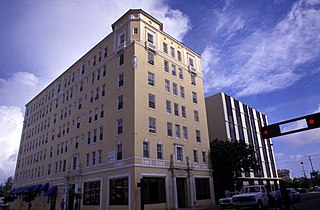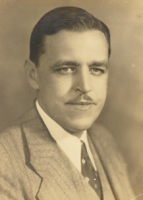
Lake Worth Beach, previously named Lake Worth, is a city in east-central Palm Beach County, Florida, United States, located about 64 miles (103 km) north of Miami. The city's name is derived from the body of water along its eastern border known as the Lake Worth Lagoon, which was named for General William J. Worth, who led United States Army forces during the last part of the Second Seminole War. Lake Worth Beach is situated south of West Palm Beach, southeast of Lake Clarke Shores, east of Palm Springs, and north of Lantana, while a small section of the city also partitions the town of Palm Beach. The 2010 census recorded a population of 34,910, which increased to 42,219 in the 2020 census. Lake Worth Beach is within the Miami metropolitan area, which was home to an estimated 6,138,333 people in 2020.

The Florida East Coast Railway is a Class II railroad operating in the U.S. state of Florida, currently owned by Grupo México.

The Seaboard Air Line Railroad, which styled itself as "The Route of Courteous Service", was an American railroad that existed from April 14, 1900, until July 1, 1967, when it merged with the Atlantic Coast Line Railroad, its longtime rival, to form the Seaboard Coast Line Railroad. Predecessor railroads dated from the 1830s and reorganized extensively to rebuild after the American Civil War. The company was headquartered in Norfolk, Virginia, until 1958, when its main offices were relocated to Richmond, Virginia. The Seaboard Air Line Railway Building in Norfolk's historic Freemason District still stands and has been converted into apartments.

Hollywood station is a train station in Hollywood, Florida, which is served by Tri-Rail and Amtrak. The station is located at 3001 Hollywood Boulevard, just west of I-95 and State Road 9.

Fort Lauderdale station is a train station in Fort Lauderdale, Florida. It is served by Tri-Rail and Amtrak. The station is located on Southwest 21st Terrace, just south of West Broward Boulevard.

West Palm Beach station is a train station in West Palm Beach, Florida. It is served by Amtrak passenger rail and Tri-Rail commuter rail service. It is located at 203–209 South Tamarind Avenue, south of First Street/Banyan Boulevard.

The Hialeah Seaboard Air Line Railway Station is a historic Seaboard Air Line Railroad depot in Hialeah, Florida. It is located at 1200 Southeast 10th Court.

The Delray Beach Seaboard Air Line Railway Station is a historic Seaboard Air Line Railway depot in Delray Beach, Florida, United States. The station is located at 1525 West Atlantic Avenue.

The Naples Seaboard Air Line Railway Station is a historic Seaboard Air Line Railway depot in Naples, Florida. It is located at 1051 5th Avenue, South.

The Dixie Court Hotel was a historic hotel in West Palm Beach, Florida. It was designed by Harvey & Clarke and was built in 1926.

The Hialeah Park Race Track is a historic racetrack in Hialeah, Florida. Its site covers 40 square blocks of central-east side Hialeah from Palm Avenue east to East 4th Avenue, and from East 22nd Street on the south to East 32nd Street on the north. On March 5, 1979, it was added to the U.S. National Register of Historic Places. Another listing for it was added in 1988. The Hialeah Park Race Track is served by the Miami Metrorail at the Hialeah Station at Palm Avenue and East 21st Street.
The Seaboard Air Line Depot can refer to the following former and active train stations previously used by the Seaboard Air Line Railroad, many of which are listed on the National Register of Historic Places:
Louis Semple Clarke, or Semple Clarke or simply LS, (1866-1957) was a pioneering businessman and engineer in the American automotive industry. One of the central founders of The Autocar Company, Clarke was also an inventor who made numerous contributions to the development of modern motor vehicles, including innovations in the use of the drive shaft, circulating motor oil, sparkplugs, and the American convention of placing a vehicle's steering wheel on the left.

Wilson Brothers & Company was a prominent Victorian-era architecture and engineering firm based in Philadelphia, Pennsylvania. The company was regarded for its structural expertise.

The Clematis Street Historic Commercial District is a U.S. historic district located in West Palm Beach, Florida. The district runs along the 500 Block of Clematis Street. It contains 12 historic buildings.

Gustav Adam Maass Jr. (1893–1964) was an American architect working primarily in the Mediterranean Revival style who designed public buildings and private homes in and around Palm Beach, Florida, from the 1920s until his death in 1964.

The architectural firm of Kiehnel and Elliot was established in Pittsburgh, Pennsylvania, in 1906. The firm did substantial work in Florida, and moved to Miami in 1922. From 1926, it was known as Kiehnel, Elliot and Chalfant.

The Homestead Seaboard Air Line Railway Station is a historic Seaboard Air Line Railroad depot in Homestead, Florida. The station is located at 214 Northwest 9th Terrace, approximately three-quarters of a mile west of downtown Homestead.

The Seaboard–All Florida Railway was a subsidiary of the Seaboard Air Line Railroad that oversaw two major extensions of the system in the early 1920s to southern Florida on each coast during the land boom. One line extended the Seaboard's tracks on the east coast from West Palm Beach down to Fort Lauderdale and Miami, while the other extension on the west coast extended the tracks from Fort Ogden south to Fort Myers and Naples, with branches from Fort Myers to LaBelle and Punta Rassa. These two extensions were heavily championed by Seaboard president S. Davies Warfield, and were constructed by Foley Brothers railroad contractors. Both extensions also allowed the Seaboard to better compete with the Florida East Coast Railway and the Atlantic Coast Line Railroad, who already served the lower east and west coasts of Florida respectively.

The Royal Poinciana Way Historic District is a historic commerce and residential district in Palm Beach, Florida. The district is bounded by the area from 207-283 Royal Poinciana Way, 95-118 North County Road, and 184-280 Sunset Avenue, with some exceptions. There are 36 buildings within the district, 26 of which are considered contributing properties. The Royal Poinciana Way Historic District became a listing in the National Register of Historic Places (NRHP) on September 17, 2015. A post office located at 95 North County Road has also been listed in the NRHP since 1983. Further, the town of Palm Beach considers the post office, Bradley House Hotel, and the Biltmore Apartments as town landmarks.





















